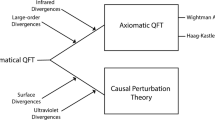Abstract
We complete the first stage of constructing a theory of fields not investigated before; these fields transform according to Lorentz group representations decomposable into an infinite direct sum of finite-dimensional irreducible representations. We consider only those theories that initially have a double symmetry: relativistic invariance and the invariance under the transformations of a secondary symmetry generated by the polar or the axial four-vector representation of the orthochronous Lorentz group. The high symmetry of the theory results in an infinite degeneracy of the particle mass spectrum with respect to spin. To eliminate this degeneracy, we postulate a spontaneous secondary-symmetry breaking and then solve the problems on the existence and the structure of nontrivial interaction Lagrangians.
Similar content being viewed by others
REFERENCES
L. M. Slad, Theor. Math. Phys., 129, 1369 (2001).
L. M. Slad, Mod. Phys. Lett. A, 15, 379 (2000).
I. M. Gelfand and A. M. Yaglom, Zh. Eksp. Teor. Fiz., 18, 703 (1948).
I. M. Gel'fand, R. A. Minlos, and Z. Ya. Shapiro, Representations of the Rotation and the Lorentz Groups and Their Applications [in Russian], Fizmatgiz, Moscow (1958); English transl., Pergamon, Oxford (1963).
M. Gell-Mann and M. Levy, Nuovo Cimento, 16, 705 (1960).
J. Wess and J. Bagger, Supersymmetry and Supergravity, Princeton Univ. Press, Princeton, N. J. (1983).
S. Coleman and J. Mandula, Phys. Rev., 159, 1251 (1967).
H. Weyl, The Classical Groups: Their Invariants and Representations, Princeton Univ. Press, Princeton, N. J. (1946).
A. Erdélyi et al. (eds.), Higher Transcendental Functions (Based on notes left by H. Bateman), Vol. 1, McGrawHill, New York (1953).
Author information
Authors and Affiliations
Rights and permissions
About this article
Cite this article
Slad, L.M. Toward an Infinite-Component Field Theory with a Double Symmetry: Interaction of Fields. Theoretical and Mathematical Physics 133, 1363–1375 (2002). https://doi.org/10.1023/A:1020693930170
Issue Date:
DOI: https://doi.org/10.1023/A:1020693930170




